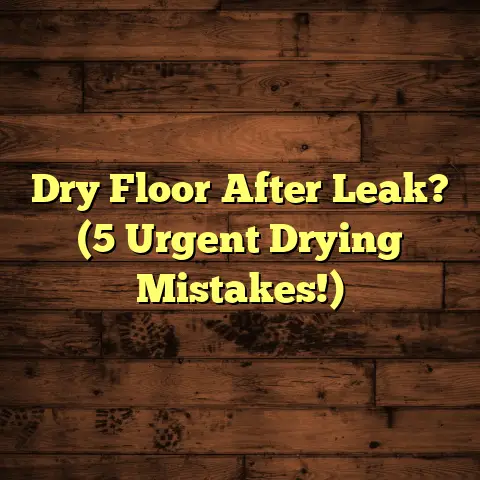Laminate vs Vinyl: Key Differences (6 Cost Factors!)
Ever feel like you’re drowning in a sea of flooring options? I get it.
As a flooring contractor for over 15 years, I’ve seen countless homeowners standing in showrooms, eyes glazed over, completely overwhelmed.
Laminate or vinyl? Which is better? Which is cheaper?
What about durability? The questions are endless!
It’s tough to decipher the jargon and understand the real differences, especially when your budget is a major factor. That’s why I’m here to break it down for you, friend-to-friend.
Let’s dive into the world of laminate and vinyl, focusing on those all-important cost factors. Ready to feel confident about your flooring decision? Let’s go!
Section 1: Understanding Laminate Flooring
Definition and Composition
What exactly is laminate flooring? Think of it as a multi-layered sandwich.
- Wear Layer: The top, clear coat that protects against scratches and wear.
- Design Layer: A high-resolution photo of wood, stone, or tile.
- Core Layer: Typically made of high-density fiberboard (HDF) or medium-density fiberboard (MDF).
- Backing Layer: Provides stability and moisture resistance (to a degree!).
Laminate is primarily made from wood byproducts bonded together with resins. It’s an engineered product designed to mimic the look of natural materials.
Visual Appeal
One of the biggest draws of laminate is its versatility.
You can find laminate that looks almost identical to hardwood, stone, or even ceramic tile.
Manufacturers are constantly improving their technology, creating incredibly realistic textures and patterns.
Want a rustic, hand-scraped wood look? Or maybe a sleek, modern tile appearance? Laminate can deliver.
Durability and Maintenance
Laminate is known for its scratch, fade, and stain resistance.
That wear layer does a pretty good job of protecting the design layer underneath.
Cleaning is a breeze – usually just a quick sweep or damp mop will do the trick.
However, it’s not invincible! Excessive moisture can be its downfall (more on that later).
Installation Process
Most laminate flooring uses a “floating” installation method.
This means the planks click together and rest on top of an underlayment, without being glued or nailed to the subfloor.
Some types can be glued down, but floating floors are far more common.
DIY installation is definitely possible with laminate, saving you some serious cash! You’ll need a few basic tools like a saw, measuring tape, and tapping block.
Section 2: Understanding Vinyl Flooring
Definition and Composition
Vinyl flooring is a synthetic material made from polyvinyl chloride (PVC) and other compounds.
It’s known for its durability, water resistance, and versatility.
There are two main types of vinyl flooring:
- Sheet Vinyl: Comes in large rolls, offering a seamless installation.
- Luxury Vinyl Planks (LVP) & Luxury Vinyl Tile (LVT): Individual planks or tiles that mimic the look of wood or stone.
LVP and LVT have become incredibly popular in recent years.
Aesthetic Variety
Vinyl flooring offers a huge range of design options. Like laminate, it can replicate the look of wood, tile, or stone.
But vinyl also allows for more creative patterns and colors that you might not find in natural materials.
The textures can be surprisingly realistic too, thanks to advancements in printing technology.
Water Resistance
This is where vinyl really shines! It’s inherently water-resistant, making it a fantastic choice for bathrooms, kitchens, and laundry rooms.
Sheet vinyl offers the best protection against water damage due to its seamless installation.
Even LVP and LVT are highly water-resistant, making them a worry-free option for moisture-prone areas.
Comfort and Sound
Vinyl tends to be softer and warmer underfoot than laminate.
It also has better sound absorption properties, reducing noise transmission between floors.
This can be a big plus if you have kids, pets, or live in a multi-story home.
Section 3: Key Differences Between Laminate and Vinyl
Alright, let’s get down to the nitty-gritty. What are the key differences between laminate and vinyl?
While both offer attractive and durable flooring solutions, the primary difference lies in their material composition and how they handle moisture.
The following six cost factors will help you make an informed decision.
Cost Factor 1: Material Cost
Let’s talk dollars and cents. Material costs can vary widely depending on the quality, brand, and style you choose.
- Laminate: Generally, laminate flooring is slightly less expensive than vinyl, especially at the lower end of the market. You can find budget-friendly options for as little as $1 to $3 per square foot. Premium laminate, with thicker wear layers and more realistic designs, can range from $3 to $7 per square foot.
- Vinyl: Budget-friendly sheet vinyl can be found for around $1 to $2 per square foot. LVP and LVT typically start around $2 per square foot and can go up to $8 or more per square foot for high-end options with enhanced features like thicker wear layers, waterproof cores, and intricate textures.
Example:
| Flooring Type | Budget Option (per sq ft) | Premium Option (per sq ft) |
|---|---|---|
| Laminate | $1 – $3 | $3 – $7 |
| Vinyl (LVP/LVT) | $2 – $4 | $4 – $8+ |
These prices are estimates and can fluctuate based on location and supplier.
Cost Factor 2: Installation Cost
Installation costs can add a significant chunk to your overall flooring budget.
- Laminate: As I mentioned earlier, laminate is often DIY-friendly, which can save you a lot of money on installation. If you hire a professional, expect to pay around $2 to $5 per square foot for labor.
- Vinyl: Sheet vinyl installation can be tricky and often requires a professional to ensure a seamless, watertight finish. LVP and LVT are generally easier to install than sheet vinyl, but still may require professional help, especially for intricate patterns or large areas. Professional installation costs range from $2 to $6 per square foot.
DIY vs. Professional:
- DIY: Save on labor costs, but factor in your time, tools, and potential mistakes.
- Professional: Higher upfront cost, but ensures proper installation and may come with a warranty.
Cost Factor 3: Lifespan and Replacement Costs
How long will your flooring last? This is a crucial factor to consider, as it impacts your long-term costs.
- Laminate: With proper care, laminate flooring can last 10 to 25 years. However, if it gets damaged by moisture, it may need to be replaced sooner.
- Vinyl: Vinyl flooring, especially LVP and LVT, is known for its durability. It can last 15 to 30 years or more with proper maintenance. Its water resistance also contributes to a longer lifespan.
Replacement Costs:
Replacing flooring is a significant expense. Consider the cost of removing the old flooring, purchasing new materials, and installation. Choosing a longer-lasting option can save you money in the long run.
Cost Factor 4: Maintenance Costs
Maintenance is an ongoing cost that many homeowners overlook.
- Laminate: Requires regular sweeping and occasional damp mopping. Avoid excessive water, as it can damage the core layer. Special laminate floor cleaners are recommended.
- Vinyl: Very easy to maintain. Regular sweeping and mopping with a mild detergent are usually sufficient. Its water resistance makes it less susceptible to damage from spills and cleaning.
Cleaning Supplies:
Both laminate and vinyl require relatively inexpensive cleaning supplies. However, specialized laminate cleaners may be slightly more expensive than general-purpose cleaners.
Cost Factor 5: Resale Value
Will your flooring choice impact your home’s resale value? It’s worth considering, even if you’re not planning to sell anytime soon.
- Laminate: Can be a selling point, especially if it mimics the look of hardwood at a lower cost. However, buyers may perceive it as less desirable than real hardwood or high-end vinyl.
- Vinyl: High-quality LVP and LVT are becoming increasingly popular with homebuyers. Their durability, water resistance, and realistic designs can add value to your home.
Perception Matters:
Ultimately, the impact on resale value depends on the overall quality and appearance of the flooring. Choose a style that complements your home’s aesthetic and is well-maintained.
Cost Factor 6: Warranty and Guarantees
Always check the warranty before making a flooring purchase.
- Laminate: Warranties typically cover manufacturing defects and wear-through of the wear layer. They may range from 5 to 25 years, depending on the quality of the product.
- Vinyl: Warranties often cover manufacturing defects, fading, and staining. LVP and LVT warranties can range from 10 years to lifetime, depending on the product and manufacturer.
Read the Fine Print:
Pay close attention to the terms and conditions of the warranty. Understand what is covered and what is not. Improper installation or maintenance can void the warranty.
Section 4: Advantages and Disadvantages of Laminate Flooring
Let’s weigh the pros and cons of laminate.
Advantages
- Affordability: Generally less expensive than vinyl, especially at the lower end.
- Aesthetic Versatility: Available in a wide range of styles that mimic wood, stone, and tile.
- Ease of Installation: DIY-friendly, saving on installation costs.
- Durability: Resistant to scratches, fading, and stains.
Disadvantages
- Susceptibility to Moisture Damage: Can warp or swell if exposed to excessive moisture.
- Lack of Refinishing Options: Cannot be sanded or refinished like hardwood.
- Potential Noise Issues: Can be noisy underfoot, especially without a proper underlayment.
- Less Comfortable: Typically harder and colder underfoot than vinyl.
Section 5: Advantages and Disadvantages of Vinyl Flooring
Now, let’s examine the pros and cons of vinyl.
Advantages
- Water Resistance: Highly water-resistant, making it ideal for bathrooms, kitchens, and laundry rooms.
- Comfort: Softer and warmer underfoot than laminate.
- Extensive Design Choices: Available in a wide range of colors, patterns, and textures.
- Durability: Resistant to scratches, dents, and stains.
- Sound Absorption: Reduces noise transmission between floors.
Disadvantages
- Susceptibility to Dents and Scratches: Can be dented by heavy furniture or scratched by sharp objects.
- Environmental Concerns: Made from PVC, which is a petroleum-based product.
- Possibility of Fading: Colors may fade over time with prolonged exposure to sunlight.
- Can be More Expensive: High-end LVP and LVT can be more expensive than laminate.
Section 6: Making the Right Choice for Your Home
Okay, you’ve got the facts. Now, how do you choose the right flooring for your home?
Personal Preferences
Consider your personal style, lifestyle needs, and specific room requirements.
- Style: Do you prefer a traditional, rustic, or modern aesthetic?
- Lifestyle: Do you have kids, pets, or high-traffic areas?
- Room Requirements: Will the flooring be exposed to moisture, heavy use, or direct sunlight?
Use Cases
Here are some ideal scenarios for choosing laminate versus vinyl:
- Laminate:
- Living rooms, bedrooms, and hallways with low moisture exposure.
- Homes where affordability is a primary concern.
- DIY projects where ease of installation is important.
- Vinyl:
- Bathrooms, kitchens, and laundry rooms where water resistance is crucial.
- Homes with kids or pets where durability and easy cleaning are essential.
- Basements or other areas prone to moisture.
Example Scenario:
Let’s say you’re renovating a basement bathroom. Water resistance is a top priority. In this case, vinyl flooring (especially sheet vinyl or LVP with a waterproof core) would be the better choice.
Conclusion: Summarizing Key Differences
Choosing between laminate and vinyl flooring can feel overwhelming, but understanding the key differences and cost factors can make the decision much easier.
Remember:
- Laminate: More affordable, DIY-friendly, but susceptible to moisture.
- Vinyl: Water-resistant, comfortable, durable, but can be more expensive.
Consider your budget, lifestyle, and specific room requirements. Research different brands and styles, and read reviews from other homeowners.
Ultimately, the best flooring choice is the one that meets your needs and fits your personal style.
Don’t be afraid to ask questions, get samples, and seek professional advice.
Happy flooring!




